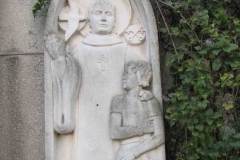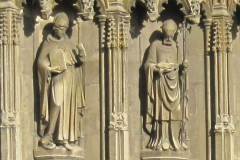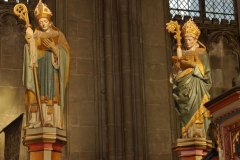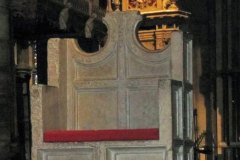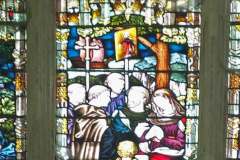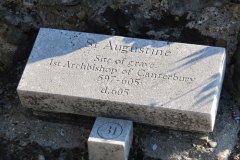Benedictine monk and first Archbishop of Canterbury
Augustine served as prior to St Andrew’s monastery in Rome before being commissioned in 596 by Pope Gregory the Great to take the gospel to the ‘Angles’ (now Anglo Saxons). Gregory before he was Pope had been impressed with the fair complexion of Anglian boys in the slave market and remarked ‘Angels not Anglians’. This is commemorated in a stone relief outside St Thomas’ Roman Catholic church in Burgate. Augustine made his way towards England but had doubts and turned back. With renewed instructions from the pope, he continued with his 40 followers, and landed at Ebbsfleet (near Ramsgate) in 597, and made his way to Canterbury. Here it seems the monks were well received by Ethelbert, king of Kent – no doubt primarily because the king’s wife Bertha was already a Christian. Augustine’s early preaching and baptisms, possibly based on the church of St Martins, were successful, and by the early 600s he had baptised king Ethelbert, was ordained archbishop, had clarified the administrative arrangements for the new church, and had founded both the new cathedral on its present site and established the abbey nearby, now known as St Augustine’s abbey. Before his death in 604 (the same year as Gregory), he had established a second see in Rochester. He was buried (and twice re-buried) in St Augustine’s abbey – since 1091 he lies in the central apse of the east end.
What to see (a few of many Augustinian visual links in the cathedral and city):
- an image of St Augustine can be seen outside St Thomas’ Roman Catholic church (Image 1)
- images of St Augustine and Lanfranc can be seen outside the south west porch (Image 2)
- Augustine is also depicted on the access stairs to the nave pulpit (Image 3)
- St Augustine’s chair (Image 4) dates from around 1200 so was clearly never used by Augustine himself
- the Chapter House includes two windows to St Augustine – one (Image 5) showing Augustine preaching to King Ethelbert and Queen Bertha
- Augustine was buried at St Augustine’s abbey (Image 6)
Source: see standard cathedral sources; also Green (1997); Taylor (2110); ODNB
DL

